 |
Castillo de Santa Catalina
Cádiz, Spain
|
|
 |
Constructed: 1598
Used by: Spain
Conflict in which it participated:
Defenses against various semi-piratical English thrusts,
War of the Spanish Succession
|
In what seems like an endless litany of "most important" cities, ports, and forts of the Spanish Empire, Cádiz could actually be a contender for the definite article! Through much of Spain's glorious period of gleeful colonial subjugation and theft from the New World, Cádiz was the destination for Spain's heavily-laden treasure ships. |
 |
|
|
Founded by the Phoenecians around 1104BC, Cádiz is one of the oldest standing cities in Western Europe. Cádiz was ruled by the Carthaginians, Romans, Visigoths and Moors over the next two millennia, until Alfonso X of Castile (1221-1284) reconquisted it in 1262, which was part of the process of carving modern Spain from the unstable stone that was medieval Europe.
|
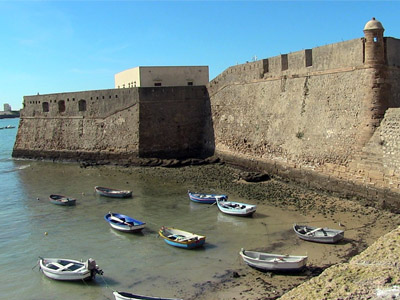 Those harmless-looking little boats sure seem like a potential security risk to me, but I'm no securitist. Those harmless-looking little boats sure seem like a potential security risk to me, but I'm no securitist. |
 |
Those of us who were educated in the United States in the second half of the 20th century were taught that Christopher Columbus (1451-1506), the Italian explorer who "discovered America" on behalf of Spanish monarchs Ferdinand II of Aragon (1452-1516) and Isabella I of Castile (1451-1504), was a True American Hero, second perhaps only to George Washington (1731-1799). In more recent decades the national opinion of Columbus has taken a full 180, and he is now considered a Truly Wicked Indigenous Persons Infector...which is a pretty accurate description of anyone involved in the European colonization of the New World, really, but I suppose that Christopher Columbus pulled the wool over our eyes for so long, he deserves special negative attention. |
|
Whatever one's enlightened opinion of Christopher Columbus, it was his discovery of the New World that ultimately led to that hemisphere's mass exploitation by the Old World, which in this particular case would be Spain. The vast treasure that supported the empire ruled from Madrid arrived at Cádiz and Seville in treasure galleons which, as time went on, became the focus for much high-seas squabbling. Everybody liked free gold, so everybody with a ship and a nominal excuse made it their business to capture those galleons. Frequently, those striving to capture Spain's ill-gotten riches were English, usually with at least a modicum of official endorsement from their monarch.
Until the 18th century, Seville was the main base for Spain's treasure fleet. 75 miles north of Cádiz, it was a much more reasonable place to receive and store Spain's riches, as it lies some 60 miles inland on the Guadalquivir River. Good luck getting at that city unmolested, seaborne pirates!
|
As the more exposed base of Spain's treasure fleet, Cádiz was considered a ripe target for conquest. Barbary corsairs attacked the city on several occasions in the first half 16th century, all of which attacks were beaten off without much in the way of damage to the city or port facilities.
These experiences inspired the construction of a gated wall separating the narrow slice of land that is Cádiz from the mainland, in the mid-16th century. In 1574 this wall was expanded to include two bastions, and the edifice was named Puerta de Tierra: Door of Earth. Though originally intended as more of a "religious altarpiece" than military fortification, the Puerta was fully militarized by improvements in the 18th century, including the addition of the pointily starfortesque bastions that we see today.
|
 |
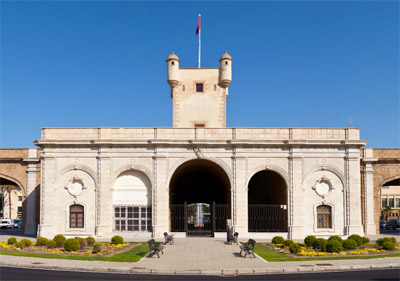 The Puerta de Tierra, which separates Cádiz from the rest of the world. The castlesque tower in the center was actually constructed in the post-castle 1850's, to serve as Tower #57 in the Line of Optical Telegraphy, a series of towers used to send signals to and from Madrid in as little as "almost two hours." Click on the pic to see a keen semi-panoramic view! The Puerta de Tierra, which separates Cádiz from the rest of the world. The castlesque tower in the center was actually constructed in the post-castle 1850's, to serve as Tower #57 in the Line of Optical Telegraphy, a series of towers used to send signals to and from Madrid in as little as "almost two hours." Click on the pic to see a keen semi-panoramic view! |
|
 Cádiz's Puerta de Tierra. Seems like all a would-be attacker would need to do to get past this obstacle would be to proceed along the highway that passes by on the left, or snake their way through the parking lot to the right. But I'm no tactician. Cádiz's Puerta de Tierra. Seems like all a would-be attacker would need to do to get past this obstacle would be to proceed along the highway that passes by on the left, or snake their way through the parking lot to the right. But I'm no tactician. |
 |
But we can't start talking about the 18th century yet, because it's still the 16th century and Cádiz doesn't even have a starfort yet. Fortunately for Starforts.com, the Spanish coast had the ever-mischievous English to inspire starfortery. A series of later 16th-century events that resulted in Spain and England butting heads even more frequently than usual in their far-flung colonies led to the instigation of the (undeclared and sporadic) Anglo-Spanish War (1584-1605). |
|
For those of us keeping track of such things, this latest European (sporadic and undeclared) war was really an extension of the Eighty Years' War (1568-1648) which was primarily focused on the Dutch fighting to rid themselves of their Spanish masters...but the English were always happy to get involved in anything that involved fighting someone.
In this (unspoken and intermittent) war, Spain's King Philip II (1527-1598) saw an opportunity to dislodge England's Queen Elizabeth I (1533-1603), whose untoward Protestantism stuck in the craws of all decent Catholics. Philip "the prudent" organized the invasion of England by a French army, borne by his mighty Armada. To this end, in April of 1587 many Spanish and French ships were concentrated at Cádiz and along the Portuguese coast in preparation for this effort.
|
Enter Sir Francis Drake (1540-1596), stage left. An accomplished sailor who completed history's second recorded circumnavigation of the earth from 1577 to 1580, Drake arrived at the Bay of Cádiz on April 29, 1587, in command of about 25 ships of assorted sizes. Through the night of the 29th and the 30th, the English fleet darted about, destroying this and capturing that. Shore batteries fired continually at the English, to little effect.
Drake and his fleet departed from Cádiz on May 1 and continued their mission of destruction along the Spanish and Portuguese coast for another couple of weeks, ultimately destroying or capturing over 100 Spanish vessels. Though not a crippling blow, Drake's intervention delayed the Spanish Armada's planned attack on England for a year.
|
 |
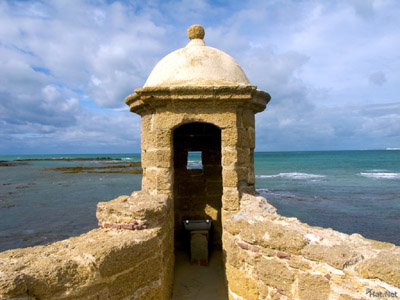 One of the Castillo's lovely garitas. One of the Castillo's lovely garitas. |
|
This event, which became known as Singeing the King of Spain's Beard, illustrated the need for, among other things, proper fortification at Cádiz. The batteries guarding the port were clearly not up to the task, but Spain was too busy going bankrupt every few years (despite massive infusions of gold from the New World) to spend money on dumb old Cádiz, and required further proof that a starfort was absolutely necessary.
No problem, sang out England and Holland! 1596 brought the most destructive raid against Cádiz to date. In June of that year a combined English/Dutch force led by Charles Howard, First Earl of Nottingham (1536-1624) and Robert Devereux, Second Earl of Essex (1565-1601) captured Cádiz, looted everything, burned everything else, and took many of the city's prominent citizens back to England to hold for ransom.
Which was quite enough for King Philip, who was through with prudence and was now ready to build a starfort at Cádiz. Military engineer Cristóbal de Rojas (1555-1614), author of Theory and Practice of Fortification, Spain's first published work on the art of fortification, was ordered to bring about this starfortification, and about time too, as this page is already sixteen paragraphs long, but we finally have a starfort about which to make more paragraphs!
|
 Google Earth, I love you so. May I please bear you some children? Google Earth, I love you so. May I please bear you some children? |
 |
The Castillo de Santa Catalina was named after Saint Catherine of Alexandria, a martyr of the 4th century. One of the "auxiliary saints," Catherine is invoked against sudden death, and is the patroness of schoolchildren, philosophers, prisoners and people who make their living with wheels, such as knife sharpeners, carters, cyclists and, assumedly, professional hula-hoopers.
Rojas died before the Castillo was complete, which may or may not have been why the finished product was not as ambitious as had been initially conceived: His original vision included a vast citadel right next to the Castillo, but once he was dead, so died his citadellian dream. |
|
Regardless, Cádiz now had a starfort, which was precisely what it needed. Or more precisely what the city needed was a will to fight and a disorganized enemy, the latter of which was provided by the English when they returned in 1625 (and were repelled) and 1655-57, when Admiral Robert Blake (1598-1657) blockaded the port, to no real result. Did the Castillo de Santa Catalina play a role in these victories? Certainly it had to have done something, but history seems conspicuously silent on that account.
|
In 1693, a chapel dedicated to Saint Catherine (Santa Catalina) was finally constructed within the Castillo of our current interest...which one might imagine would strengthen the fighting spirit of those tasked with defending the fort, but its presence did not prevent the British from capturing the Castillo in 1702.
In 1700, the weirdly deformed Spanish King Charles II (1661-1700) had left this plane of existence. Having no legitimate heirs in the pipeline (as the Habsurgs had successfully inbred themselves out of existence), he named as his successor the grandson of reigning French King Louis XIV (1638-1715).
|
 |
|
|
Other European powers took issue with Charles' dying proclamation, as so closely binding France and Spain under one Bourbon flag would upset the all-important balance of power in Europe, and thus the War of the Spanish Succession (1702-1715) broke out soon thereafter.
A combined Anglo/Dutch force descended upon Cádiz in August of 1702, with the intent of capturing the city and port so as to not only deprive Spain of its link to the New World (sand bars had by this time rendered the Guadalquivir River unnavigable to oceangoing ships, forcing the Spanish government to transfer its American trade fully from Seville to Cádiz), but to also serve as a bastion for rebel Spanish nobles with an interest in joining the anti-Bourbon cause.
|
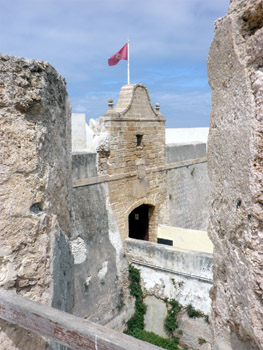 The Castillo de Santa Catalina's main gate. The Castillo de Santa Catalina's main gate. |
 |
The British and Dutch managed to make a successful landing near Cádiz and capture our Castillo, but were unable to control themselves amongst the unguarded warehouses crammed with food, alcoholic beverages and assorted treasure in the city. Looting swiftly became general, with churches and convents being included in the fracas. Drunken troops were now more interested in returning home with their newfound riches than continuing the fight, and any hopes of high-minded, anti-Bourbon Spaniards joining up with this looty mess of an army were dashed. After spending nearly two months in control of Cádiz and our Castillo, the British and Dutch were forced to depart, having accomplished little other than the personal enrichment and thorough intoxication of many of their soldiers.
Cádiz flourished in the 18th century, as the portal through whence passed Madrid's American riches. In 1769 King Charles III (1716-1788) decreed that the Castillo de Santa Catalina should henceforth be utilized as a military prison, conveniently placed as it was to incarcerate the growing numbers of independence-minded hooligans in Spain's American colonies.
|
|
Which function it served until 1991, when Spain's Ministry of Defense "ceased to make official use" of the fort. A few restoration efforts since then have been relatively unsuccessful (the haphazard slapping of concrete onto a starfort's sacred walls doth not a restoration make), though a more thoughtful conservation effort is, reportedly, currently under way.
|
1706 saw the construction of this non-starfort on an island just to the west of Cádiz. This little island had been the home to a temple to Kronos, the ancient Greek Titan, father of such mythological celebrities as Zeus, Poseidon and Hades.
|
 |
|
|
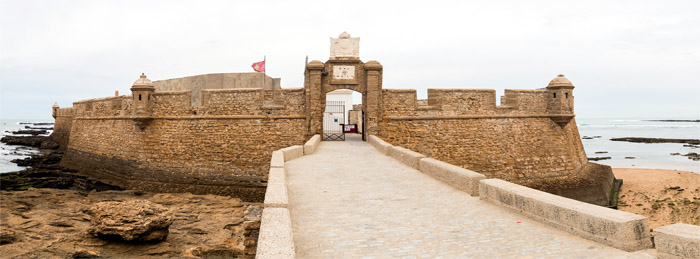 Well, the Castillo de San Sebastián certainly looks like a Spanish starfort, with those nice spiny garitas! Well, the Castillo de San Sebastián certainly looks like a Spanish starfort, with those nice spiny garitas!The intent of securing Cádiz's "northern flank" was the purpose for this fort, sensible at the beginning of the era in which that port had just been named the sole destination of Spain's treasure fleet. Also used as a prison for Spain's political enemies, this Castillo remained separated from the mainland until 1860, when a causeway was built to connect it to the city. This fort was named for Saint Sebastian, who is mostly known for being tied to a post and shot with arrows. Saint Sebastian was supposedly a protector from bubonic plague, which may be the reason this fort was named for him: A chapel had been built on this island in 1457 by the crew of a Venitian ship that was suffering from the plague. Those with a sharp eye may have caught the Castillo de San Sebastián as a backdrop to Pierce Brosnan and Halle Berry exchanging sexy witticisms in the 2002 James Bond movie, Die Another Day.
|
|
|
|
|
|
 |




